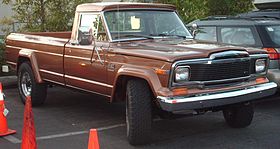Jeep J-Series
| Jeep Gladiator / Jeep Pickup | |
|---|---|

Jeep J20 Pickup
|
|
| Overview | |
| Manufacturer |
|
| Production | 1962-1988 |
| Body and chassis | |
| Body style | 2-door pickup truck |
| Layout | Front-engine, rear-wheel drive / four-wheel drive |
| Related | Jeep Wagoneer (SJ) |
| Powertrain | |
| Engine | |
| Transmission | |
| Dimensions | |
| Wheelbase |
|
| Chronology | |
| Predecessor | Willys Jeep Truck |
| Successor | Jeep Comanche |
The Jeep Gladiator (or Jeep Pickup) is a full-size pickup truck based on the large SJ (Jeep Wagoneer) platform that was built and sold under numerous marques from 1962 to 1988. The Jeep pickup design was noteworthy for being in production for more than 26 years with only minor mechanical changes. The Gladiator was the basis of the first post-war U.S. Army trucks designed to be civilian vehicles and adapted to military use. Numerous versions of the Jeep pickup were built in other markets, including Mexico by Vehículos Automotores Mexicanos.
Introduced in 1962 for the 1963 model year, the Gladiator was a conventional body on frame pickup design that shared its basic frame architecture and front end with Jeep Wagoneer four-wheel-drive station wagon.
Designations were J200 (short wheelbase trucks, up to mid-1965); J2000; J300 (long wheelbase trucks, up to mid-1967); J3000; and J4000, the first model with a longer 131-inch (3,300 mm) wheelbase.
Gladiators were available in RWD and 4WD, and came either with a solid front axle, or independent front suspension with optional dual rear wheels.
Gladiator trucks were available as: Cab and Chassis; Wrecker; Stake Bed; and chassis-mounted campers with extended wheelbases. The load bed options were Townside, Thriftside (a "step-side"), and Stake Bed, with up to 8,600 lb (3,901 kg) G.V.W. and almost two-ton payload capacity.
A new overhead cam Jeep Tornado engine 230 cu in (3.8 L) straight-six producing 140 hp (104 kW; 142 PS) was standard. Innovations for four-wheel-drive pickups included optional automatic transmission (an industry first), as well as power brakes, power steering, and a Power Take-Off unit for numerous accessories that included snow plows and push plates.
In early 1963, Willys Motors changed its name to Kaiser Jeep Corporation.
...
Wikipedia
